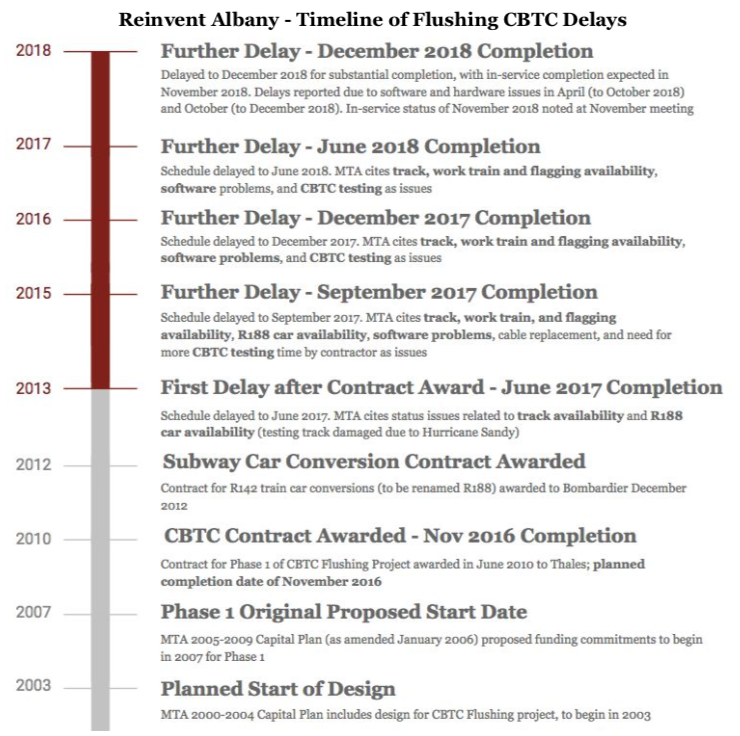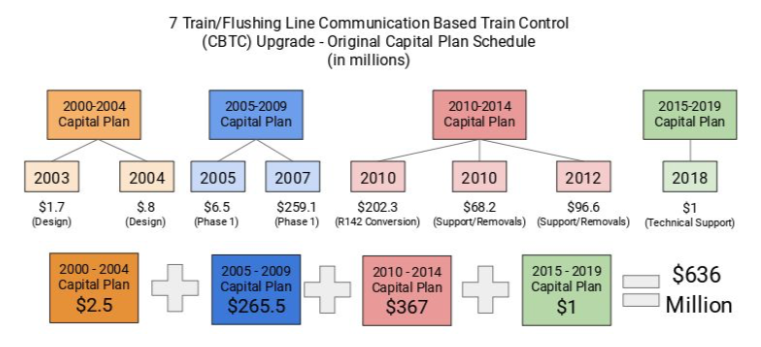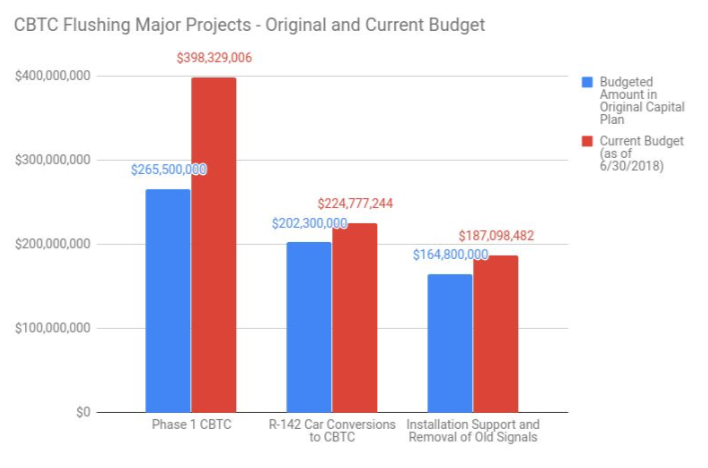Flushing 7 Train Signals Late and Over Budget – What Lessons Will the MTA Learn for Full System Upgrade?
For Immediate Release
November 13, 2018
MTA’s 15 Year Effort to Modernize Signals On #7 Train Raises Major Questions
Key Project at Least $157 Million Over Budget and 5 Years Behind Schedule
How Will MTA Install CBTC Signals Across Entire Subway in 10 Years Instead of 40?
What has MTA Learned from Much Delayed Project?
Watchdog group Reinvent Albany today called on the Capital Plan Oversight Committee (CPOC) of the Metropolitan Transportation Authority to direct MTA staff to conduct and publicly release an in-depth “lessons learned” report about what worked well, and what did not during the installation of Communications Based Train Control (CBTC) on the Flushing 7 line. The line is expected to have CBTC in-service by the end of November, with full completion of the project in December 2018.
CBTC is the cornerstone of NYC Transit President Andy Byford’s efforts to modernize the system and end crippling subway delays. Yet, Byford and the MTA have not explained how they will install CBTC in ten years instead of the previously planned 40 years. The Flushing Line/#7 Line is 5 years late and at least $157 million over budget, and offers key lessons to the MTA and its vendors on what they should be doing and not doing on future CBTC projects.
Below is a timeline of the CBTC project, as analyzed by Reinvent Albany from the MTA’s capital plans and information provided to the Capital Plan Oversight Committee of the MTA Board.
The project is 15 years in the making, with design work planned to be started in 2003, as per the MTA’s 2000-2004 Capital Plan. Phase 1 – the work being finished now – was slated to start in 2007, with the MTA planning to commit substantial funds at that time. Yet the actual contract was not awarded to Thales until 2010, 3 years later. The work with Thales had a planned completion date of November 2016, and we are now in November 2018, more than 2 years later. Together, this means that the project is at least 5 years behind the schedule originally planned by the MTA.
In reviewing CPOC’s board materials since 2011, Reinvent Albany found a pattern of issues that may have contributed to delays, yet it is not clear if the MTA Board has conducted this review. In receiving staff reports on a quarterly or less basis, the Board is seeing information regarding a snapshot in time, often with re-baselined and not aggregate information.
Since 2011, the staff has reported to CPOC that software issues could cause delays – either “yellow” or “red” in their staff reports – 10 times. MTA staff repeatedly raised concerns about construction delays caused by their inability to suspend service and close tracks. (Track “availability” called “General Order (G.O.) availability” by MTA, was raised as a concern 9 times.) CBTC testing was an issue 5 times, and R188 car availability a concern 3 times (though it should be noted that Hurricane Sandy damaged test tracks that would have enabled this project to advance sooner).
Signal modernization with Communication Based Train Control (CBTC) for the Flushing 7 line was first proposed in the MTA’s 2000-2004 Capital Plan, which set aside $2.5 million for design. The 2005-2009 plan added $265.5 million for Phase 1, the 2010-2014 plan added $202 million for R-142 car conversions (to become R188 cars) and $165 million for in-house support work, and lastly the 2015-2019 plan added $1 million for technical support. This totals $636 million originally planned to get CBTC operational on the Flushing Line.
According to data from the MTA’s Capital Dashboard (which is current as of 6/30/2018), the largest components of the CBTC Flushing project have all had price increases from the original proposed capital plan budget. The CPOC’s November 2018 report cites $588 million as the total cost, which appears to be just for the Phase 1 construction and in-house support and removals. These projects were originally slated to cost $430 million, meaning that these components are $157 million over budget. See the chart below of MTA Capital Dashboard data (current as of 6/30/2018 – note the website has not been updated) and original capital plan information.
In recent months, the MTA has repeatedly acknowledged that it has a credibility problem. The MTA has an important opportunity with the expected completion of the Flushing Line to better create better public confidence and show that it can learn as it seeks to modernize systemwide. This is essential to obtaining state legislative support for the Fast Forward Plan, which calls for doing in 10 years what would normally would take the MTA 40 years to complete.
New York City Transit’s President Andy Byford’s Fast Forward Plan includes CBTC upgrades to 11 lines total, including continuing work on the 7, Queens Blvd (E/F/M/R), Culver (F) and 8th Avenue lines (A/C/E), over a 10 year period. After the first five years, an estimated 3 million subway riders would use CBTC equipped trains lines, going up to 5 million riders over a 10-year period. The Fast Forward Plan also proposes having all subway cars be CBTC-equipped, with all new cars purchased able to run CBTC, and old cars upgraded with new CBTC equipment.
MTA staff are in the best position to explain what lessons can be learned from the #7 Train CBTC project, and should provide a report to the public, legislators, journalists and outside experts of their analysis of what worked and didn’t with Flushing CBTC, outside of the context of the MTA’s regular board and committee meetings. MTA board meetings encompass a wide variety of issues, and board materials are provided in summary form that does not lend itself to in-depth analysis. MTA staff and vendors probably know what went right and wrong on the #7 CBTC project, but the public does not. As part of restoring public confidence and gaining public support, the MTA needs to be transparent about late and over budget projects and explain how it is learning lessons that allow it to continuously improve.
Key Questions for MTA Lessons Learned Report on CBTC #7 Train
In conducting its review of CBTC implementation on the #7 Flushing Line, Reinvent Albany is providing the following key questions to the MTA which we believe can help guide their analysis. These questions were developed by reviewing MTA CPOC materials, and in speaking with policy and industry experts.
- Regarding software, which was the biggest issue cited by MTA staff as a concern (10 times total to the CPOC), does the MTA staff need greater training and support? Given the desire for interoperability and greater choice of CBTC vendors, are lessons being learned with the Siemens/Thales partnership on Queens Boulevard that would have been helpful for the 7 line? In general has this leader/follower model been effective? Should CBTC software be owned by the MTA, or open source rather than owned by the vendor, subject to safety review?
- How should the MTA handle track closures/General Order G.O. availability for future CBTC projects? Track availability, as well as work train and flagging availability, was cited as a major concern for the Flushing line, appearing as a concern 9 times in staff reports to the CPOC. This issue is particularly relevant as the MTA prepares for the L train shutdown, as lessons can be learned from that process, and enhanced community engagement may lead to greater support for future line closures rather than only night and weekend work.
- Were contractors able to effectively work with all necessary teams at the MTA, such as signals staff, line managers, track crews and others responsible for various aspects of the 7 line? Was there an effective signal point of contact? What can help create a better systems approach to signal modernization?
- Were there staff redundancies that could have been eliminated in the in-house support and removals component of the project?
- Have there been an inordinately large number of change orders for this project (at least 63 have been requested, per Reinvent Albany’s research)? If so, what is this indicative of? Was the initial scoping of the project not done sufficiently?
- What were the drivers of cost increases? Beyond the expansion of the 7 line, what contributed to cost increases – insufficient scoping, unfavorable bidding, project delays, lack of competition, etc.?



